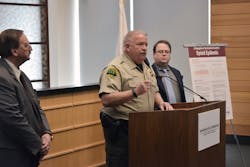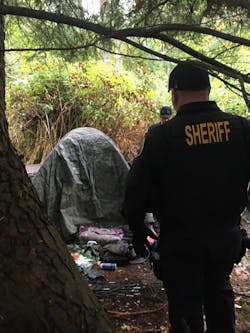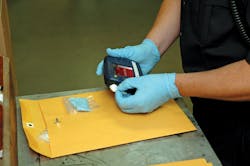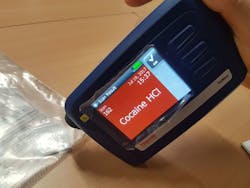Law Enforcement’s Role in the Opioid Epidemic
Approximately 180 Americans die daily from opioid overdoses, including heroin, prescription pain killers and the up and coming killer, fentanyl. In 2015 and 2016, life expectancy lowered for the first time in decades with overdose now the leading cause of death for Americans under age 50. Much of this increase is being driven by fentanyl and its analogues, commonly called fentalogs. One fentalog, carfentanil is 100 times more potent than fentanyl. Often believed to be just a public health crisis, the opioid epidemic is staring law enforcement in the face as the bodies pile up.
Partners in the crisis
Task forces are one of the ways the players affected by the opioid epidemic are coming together. In 2013, the U.S. Attorney established the Heroin and Opioid Task Force. It brought together, “a diverse group of stakeholders, including law enforcement, the medical community, people in recovery, treatment professionals, judges, public health professionals, educators and others. It focuses on solutions from four perspectives: law enforcement; education and prevention; healthcare policy; and treatment.” In a February 2018 address, U.S. Attorney General Jeff Sessions outlined more recent task forces:
• August 2017: Opioid Fraud and Abuse Detection Unit which uses data analytics to determine “who is prescribing the most drugs, who is dispensing the most drugs and whose patients are dying to overdoses.”
• October 2017: Six new law enforcement teams were created to focus on the flow of heroin and illicit fentanyl into the U.S.
• January 2018: J-CODE: Joint Criminal Opioid Darknet Enforcement Team targeting the sale of online drugs.
• February 2018: Prescription Interdiction & Litigation (PIL) Task Force. Described by Sessions as, “a new front in the war on the opioid crisis,” PIL is going after manufacturers and distributors, including doctors and pharmacies.
Another important change from the top was the February 2018 addition of all fentalogs being designated as Schedule 1 under the Controlled Substances Act. This category defines drugs with no currently accepted medical use and this reclassification gives law enforcement more power to engage this crisis.
At the local level, another task force, the Snohomish County (Wash.) Opioid Response Multi-agency Coordination Group (MAC) is bringing the fight.
MAC, a version of the Incident Command System (ICS), was established by a joint resolution in Nov. 2017. Along with the Snohomish County Sheriff’s Office (SCSO), MAC includes the Snohomish County Council and the Snohomish Health District Board of Health. In the resolution “these four entities affirmed their commitment to ending the opioid epidemic in Snohomish County through strong partnerships, coordination and collaboration.”One of the first things they tackled was the idea that this was not a law enforcement issue. “The crisis is public health but the venting point is a law enforcement response when someone is committing crimes to support their heroin habit,” explains Snohomish County Sheriff Ty Trenary. “Law enforcement feels we’re the tip of the spear.” MAC addresses this by sending people with information to specific areas, such as homeless camps to try to get people help. “Nobody wants to be an addict,” Trenary states.
Detective Brian Coen, Drug Control Unit, Quincy Police Department (Mass.) agrees the crisis is a public safety issue as well. “When it starts hitting the streets, we’re on the front line,” he explains. “We’re trying to keep it out of the buyer’s hand. We see so many overdoses. We were the first police department in the country to train every one of its officers to use Narcan. We’ve saved a lot of lives but people are still overdosing and dying from this fentanyl drug. It’s the number one drug in our community right now. We rarely see heroin.”
The collaborative element of partnerships is important. “You need to think outside the box,” Trenary states. “The only way we’re going to solve this nationally is we have to hit the root cause and that’s not just a law enforcement problem.”
Collecting data
One of the things Trenary discovered through MAC was the importance of collecting data. “Our data collection was horrible,” Trenary says. “We had done a poor job truly understanding how the opioid epidemic affects everything from neonatal to elderly fall patients. How can we merge data from hospitals to clinics, from the Medical Examiner to police?” With the collected data, SCSO is now able to identify and map locations where overdoses are occurring. It also showed them the extent of the problem. SCSO analyzed a list of “frequent utilizers” of the jail, a group of 53 inmates with anywhere from three arrests in the past two years to 48 arrests in the last 12 years with an average of 17 arrests. SCSO determined 85 percent were treated for opioid withdrawal. “The number of inmates booked each week at our jail that go immediately on opioid withdrawal watch averages between 31 to 41 percent of our total bookings,” explains Trenary. With this data, they were able to come up with some solutions. “Up to November we had no idea how our crime rate reflected heroin addiction,” says Trenary. “Where is the addiction beginning? People don’t leave their houses and decide to go try heroin. The addiction starts with a prescription. Doctors are over-prescribing opioids.” SCSO asked if there were pharmacies they should work more closely with. “If we can track it then we can impact it,” he explains.Collecting data is important to plan strategies, reinforces Gates Police Department (N.Y.) Chief James Vanbrederone. “It will be a real time snapshot we can use to coordinate the prevention services and education services. Our role has changed. It’s such a lethal problem we now have to take on the role of education and recovery.” As part of this partnership, the Gate to Recovery Drop-In Center was opened in Aug. 2017 and the police department hands out information cards to all their prisoners as they leave. “So they have a hotline number if they want treatment,” Vanbrederone says. “Not everyone wants treatment but they all get the number. We now get phone calls at our office asking for the number and where to get help.”
In Snohomish County, a diversion center staffed with social workers will be opening as a place for people to wait for a spot in a residential facility.
Before gathering the data, SCSO had no idea the extent of the problem or how to fix the root cause. “I spent a ton of time as a patrol cop,” Trenary explains. “There wasn’t a problem I couldn’t solve with a pair of handcuffs and a trip to jail. You could arrest the individual and remove them from the community. The problem with this drug epidemic that I’ve never seen before is incarceration is not solving it. We can arrest people all day long. It was a revolving door.”
Although agreeing that basic arrest wasn’t the way to solve this problem, Gates Police Department took this old school policing tactic and gave it a twist. They began arresting and charging dealers with criminally negligent homicide when someone they sold to died of an overdose. “You have to create some sort of a punishment, some sort of a fear, a tool to help people think twice,” explains Vanbrederone. “We’ve successfully arrested two people. The first already pleaded out. The newest one probably will, too.”
The point of the innovative arrests was getting this crisis in front of the public and dispelling apathy. “Every time one of our animals passes away at the zoo it’s breaking news,” Vanbrederone states. He explained how recently one of their polar bears died and it was highlighted on the evening news. At the same time, 15 people died of opioid overdoses in February and nobody reported on it. “That’s a problem,” he explains. “If 15 people died of West Nile virus or the flu or pick anything else, there would be a press conference every Friday, but there’s a stigma about drug use. The average citizen has no idea about the disease and that’s why you think like that.” He explains law enforcement’s role is to be a leader and help break the silence around this epidemic. Vanbrederone explains, “If you’re a leader, running a public organization, you’re in politics. You have got to be the voice. It’s not going to happen if we, as public leaders, don’t speak up.”
Combat through technology
Along with partnerships, data collection and innovative programs, drug analysis is also helping law enforcement combat this epidemic. In many jurisdictions, patrol officers can field test drugs. A variety of different handheld technologies exist including, colorimetric wet chemistry (NIK Kits), raman spectroscopy (Thermo Fisher Scientific TruNarc and Agilent Resolve), ion mobility spectrometry (IMS) (Bruker Roadrunner), high-pressure mass spectrometry (HPMS) (908 Device MX908) and fourier-transform infrared spectroscopy (FTIR) (Thermo Fisher FTIR/Raman integrated Gemini and Agilent 4300 Handheld).
Every department has unique needs and deciding which technology to use is an individual decision. Many agencies go with raman spectroscopy due to it being more forgiving of user error, specifically putting in too much product. One raman spectroscopy device, the TruNarc is being used by departments in 45 states and 50 countries.
Quincy Police Department was the beta tester for the TruNarc in 2011 and when it hit the market in 2012 they were the first customers. Coen explains, “Officer safety was the number one reason. We really appreciate the device but if it can identify the fentanyl through the bag that’s where we really see the value.”
Although lab analysis is needed for conviction, field testing allows officers to do three things according to Coen: identify the drug, establish probable cause and indict.
On the prevention side, identifying what buyers are using helps law enforcement direct them to treatment, as well as assist in overdoses. “If we come to a scene of an overdose and the person is non-verbal, we can test it and know what they took,” says Coen. “That helps us and the medical community.”Reversing death
Addressing the opioid epidemic would not be complete without a look at the role of Narcan (naloxone). Opioid overdoses cause death by suppressing the respiratory system—people just stop breathing. Opioids attach to receptors in the brain and naloxone knocks them off restoring breathing. Working in two to five minutes, this drug reverses deadly overdoses. Although there are no contraindications, officers should be mindful of the extreme agitation that those revived can exhibit as well as the dangers of sudden opioid withdrawal. Many agencies are issuing and training their officers on this life saving antidote, including SCSO.
Since issuing naloxone to its officers as well as getting more of it into the hands of other citizens, they have seen a decline in overdose deaths. But it’s still not enough. “We need your help,” Trenary pleads with all law enforcement professionals. “We need everybody’s help.” Trenary believes that many people, including those in law enforcement, still subscribe to the philosophy of ,“Just let them die. How dare law enforcement provide naloxone? That’s natural selection.” Trenary disputes this stating, “We took an oath to protect and serve and not letting people die is part of that.”
Partnerships through task forces, using policing tools in new ways, field testing technology and equipping officers with what they need will all go a long way in fighting this deadly crisis. Trenary notes, “This is not a hug-a-thug program, but at the same token we have to try to create permanent solutions. Multiple agency coordination will solve this.” In the end, the solution is about reducing crime, making communities safer and saving lives—all solid law enforcement goals.
About the Author
Michelle Perin
Michelle Perin has been a freelance writer since 2000. In December 2010, she earned her Master’s degree in Criminology and Criminal Justice from Indiana State University.





